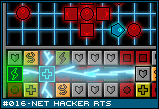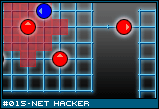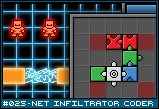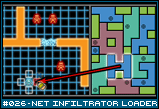| Three Hundred |
| - Index Page |
| - About... |
| - By Year |
| Collections |
| - Comp-Grid |
| - Procedural |
| - Tactics |
| - Tiny Crawl |
| - Misc |
| Previous | Mechanic #016 | Next |
![[rts1.png]](set01/img/entry016-rts1.png) This is similar to #015 - Net Hacker in that it involves a cyberspace-like theme to it, but this one is a two player real time strategy with three screens: the playing field and a program grid for both players. Like the other idea, you load programs onto this grid. The difference here is that each program is only 1x1 (not Tetris-shapes here), and a program may have an associated unit with it. For instance, loading a circle-unit into the grid will cause a circle unit to spawn on the playing field. ![[rts2.png]](set01/img/entry016-rts2.png) You can control units the old fashioned way (by clicking on the unit and giving it commands), or you can click on it's program square and then drag a line to something. If you drag a line to another unit, it will move to and guard that other unit. If you simply drag in a direction, it will start moving in that direction. Tap it, it will stop. Press down on it for a second and a context sensitive menu will appear above it.
![[rts3.png]](set01/img/entry016-rts3.png) Let's say that the Blue Pentagon is attacking a Red Circle. Each unit has a corresponding program block on the grid, highlighted here. ![[rts4.png]](set01/img/entry016-rts4.png) If the Red Circle is hit for five points of damage, this also means that the block is hit for five points of damage (technically, the unit is sharing the block's hitpoints). Assuming the block had only five hitpoints, it would be removed from the program grid, and the Red Circle unit would be removed from the field area. ![[rts5.png]](set01/img/entry016-rts5.png) However, where that block is placed may be important. If the Blue Pentagon had done more damage to the Red Circle than the Red Circle had hitpoints, the remaining damage would be distributed to neighboring program blocks. If the damage was great enough, it could then spread to the adjacent blocks of these other ones, potentially chaining into significant damage across the whole board. Also, any time a program block is damaged, either directly or adjacenctly, it is revealed to the opponent. As he discovered what your program board looks like, he may find important weaknesses in your defense through it.
Not all programs are units. Some may be utility programs which affect things on the program grid rather than the playing field. All utility programs may have multiple levels of quality. For instance an A-level Protection Block may have 30 hitpoints while a D-level only 5 hitpoints.
![[util1.png]](set01/img/entry016-util1.png) Protection Block - This block simply has a lot of hitpoints, thus is not destroyed easily. Placing these blocks between weak, disposable units and important ones could mean the difference between life and death. A similar effect could be created simply by leaving empty blocks between units (trenches), but when it comes to things like power surges or viruses, having a protection block in place will be more important.
![[util2.png]](set01/img/entry016-util2.png) Repair Block - A repair block is simple. Every few seconds, it restores a single hitpoint to a neighboring damaged program block. If there are multiple blocks, it will heal the most damaged one. It will not restore completely destroyed programs though. There is also a Reserve Block which stores up to five repair points (filled by a touching repair block with minimum priority). A Reserve Block can then heal a great number of points in one go, but since it does not create repair points by itself, it needs to be paired with a Repair Block (or two).
![[util3b.png]](set01/img/entry016-util3b.png)
![[util3.png]](set01/img/entry016-util3.png) Virus Scanner Block - Certain enemy units have the ability to infect a program block with a virus. An infected block takes a short amount of time to become fully infected. Once it is, the block turns bright green and becomes unusable to that player. Instead, the opponent can order that unit around as if it were his own. Each block infects the neighboring blocks, so if unchecked for too long, the exponential growth of the virus could prove fatal. To combat it, placing Virus Scanner Blocks around the grid. These scanner blocks will examine each neighboring block for a virus. If it finds that it is infected, it will release an anti-virus. It operates in exactly the same way as a virus, unaffecting each neighboring block as it comes to it. The anti-virus works faster than a virus. The main problem with virus scanner blocks is that a virus must have expanded enough to get near the scanner, or else you've got to place multiple scanners around the board. Also effective are protection blocks. Trenches won't slow down or stop a virus (it infects the empty slot very quickly and moves on). However, protection blocks take much longer to fully infect than other types of blocks, slowing down virus infection a bit.
![[util4b.png]](set01/img/entry016-util4b.png)
![[util4.png]](set01/img/entry016-util4.png) Surge Protection Block - Some kinds of attacks can send a power surge. A power surge extends in all four directions from the affected block, going the entire length of each row and column. Each block covered will have a percent chance of being damange, and like the virus, not all blocks are equally affected by the surge. A protection block has a unique feature. When a surge hits it, the surge will stop at it. The protection block will receive damage equal to the amount of damage done from the surge source to that block. So if four programs are damaged for three damage each, the protection block will be hit for twelve damage. If the block is destroyed, the surge still does not continue past it. Surge protection works in a similar manner. Once hit, the surge will not extend beyond it. However, that branch of the surge will do zero damage. Not only that, but there is a certain percent chance, based on the quality of the surge protection block, that the surge will return feedback to the unit which caused it. So if an enemy causes a surge on your board and hits a surge protector, he may receive a surge himself.
|



